Hooded Plover
Hooded Plover (eastern)Thinornis rubricollis rubricollis | |
|---|---|
| Kingdom: | Animalia |
| Phylum: | Chordata |
| Class: | Aves |
| Order: | Ciconiformes |
| Sub Order: | Charadrii |
| Family: | Charadriidae |
| Status | |
| Australia: | Vulnerable (EPBC Act 1999) |
| New South Wales: | Critically endangered |
| South Australia: | Vulnerable |
| Tasmania: | Not listed (TSP Act 1995) 26-10-2015 |
| Victoria: | Vulnerable (FFG Threatened List 2025) |
| FFG: | Action Statement No. 9 (pdf) |
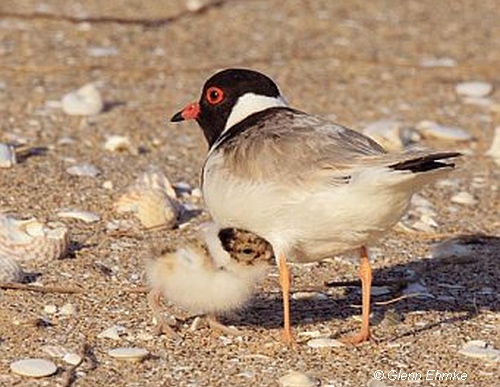
The Hooded Plover is mainly found along the southern coastline of Australia where two populations are recognised, one in Western Australia and the other in south-eastern Australia (South Australia, Victoria, Tasmania and southern New South Wales). Population estimates for south-eastern Australia vary up to 3000 birds (EA 2000) with counts in Victoria between 334-538 birds (Weston 2003), 550 (Ewers et al, 2011), 565 in November 2012, 761 in November 2022 and 682 in November 2024 (Birdlife Australia 2023 & 2024).
Previous studies indicated a decline in the order of 12 - 13% per year (Birdlife Australia 2014). In recent years in line with increased monitoring and management of nests the downward trend reversed in 2012/13 with an improved rate of hatching success.
Summary of 2024/25 breeding season
The adult Hooded Plover is about 20 cm high, sandy-brown above with a white underside. Conspicuous features when viewing in the field are its black head and a white nape (collar at base of its neck) and a broad black line extending across its lower hindneck to each side of the breast. Its bill is red with a black tip. Males and females appear similar whilst juveniles can be distinguished by the lack of black markings and red bill.
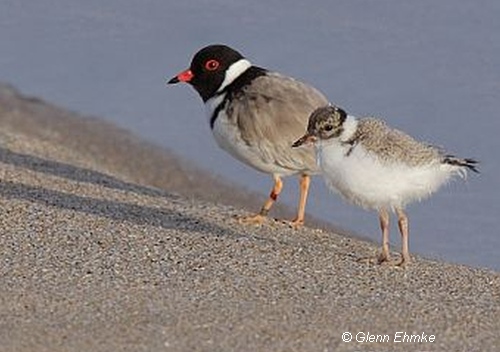
Distribution
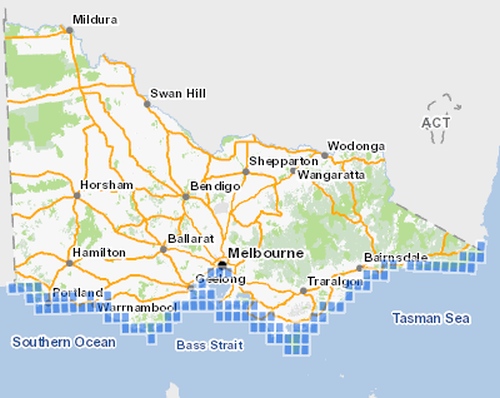
Ecology & Habitat
Hooded Plovers are most likely observed in pairs, sometimes in small groups on wide sandy ocean beaches and at mouths of rivers where wide sandy areas are formed. They are often found where seaweed and other beach washed material has been deposited which provides a certain amount of shelter and a harbour for food such as sandhoppers.
Rankings of key habitats in Victoria's Parks
(adapted from Weston 2003 and Birdlife Australia 2014).
It should be noted that although there may be variations in counts from year to year the following ranking is based on broad patterns of counts over time. Theses rankings also include important parks which had greater that 5% of the Victorian count in 2010.
- Mornington Peninsula National Park
- Belfast Coastal Reserve
- Kilcunda - Harmers Haven Coastal Reserve
- Cape Liptrap Coastal Park
- Discovery Bay Coastal Park
- Croajingolong National Park
- Great Otway National Park
- Wilsons Promontory National Park
Other important areas of coastal habitat
- Cape Conran Coastal Park -area has high productivity for relatively few pairs Kilcunda to Cape Gippsland Lakes and area between Lakes Entrance and Lake Tyers.
- Cape Liptrap to Bass Coast - high density of breeding pairs (~26 pairs).
- Phillip Island - southern and western ocean beaches with a stable population around 17 breeding pairs managed by Phillip Island Nature Park.
- Point Lonsdale to Anglesea - 9 breeding pairs in this area includes 13 km of coastline managed by Barwon Coast Committee of Management.
- Point Roadknight- Anglesea.
- Apollo Bay - 3-4 pairs occur on estuaries within the township..
- Warrnambool to Narrawong a high density of breeding pairs (35% of the Victorian population), however suffers the poorest breeding success.
- Narrawong Coastal Reserve - high breeding zone between Portland and Warrnambool.
- Point Danger, Portland - Committee of Management.
- Lower Glenelg National Park.
Belfast Coastal Reserve
In 2018 the Belfast Coastal Reserve was identified as being one of the most critical sections of coast for breeding and wintering Hooded Plovers. The Reserve holds the largest density of breeding Hooded Plovers in their entire eastern range (~12% of the Victorian population; high impact threats of racehorse training, trail bikes, off leash dogs, unregulated recreational horse riding and major coastal weeds (Word about the Hood Edition 19 winter 2018 pdf)
Feeding
The Hooded Plover is an opportunistic feeder and feeding takes place by day and night according to the availability and behaviour of prey that is, in turn, influenced by tidal levels and activity of prey. Diet consists of insects, amphipod crustaceans (sandhoppers), polychaete worms and small bivalve molluscs.
Nesting
The nesting season extends from August to February with the peak months November to January. Nesting later in the season results in a higher likelihood of fledging young successfully than nests early in the season (Birdlife Australia 2012) . Breeding is carried out on ocean beaches, nests are a depression in the sand usually in association with dry seaweed and located above average high tide levels up into the primary dunes. Breeding territories occupy approximately 1km of beach (Birdlife Australia 2014). Nests can contain two to three sand-coloured eggs with incubation about 30 days. After hatching it takes a further 35 days until the chicks can fly. A chick is considered to be fully fledged when it can fly at least 50 meters, at this stage it is referred to as a juvenile bird.
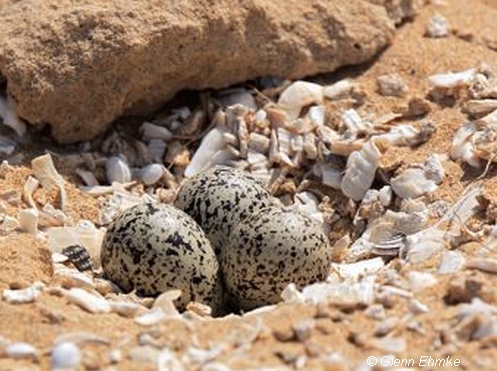
Hooded Plover nest with eggs, easily damaged by foot traffic. Image: Glen Ehmke.
Threats
An assessment of risks to Hooded Plovers has been conducted on Parks Victoria (PV) managed land (which comprises about 82% of the Victorian population). The four highest risks that have the most impact are:
- human disturbance
- introduced predators - primarily the Red Fox
- habitat modification
- dogs off leashes on beaches
Other threats include:
- horses on beaches
- vehicles on beaches
- coastal works involving sand reclamation, construction of sea wall and groynes
Overall, Hooded Plover populations are declining because of low breeding success and availability of habitat which is likely to limit the amount of breeding (Weston 2003)
Breeding success can be severely limited due to a range of natural and human related factors. High seas can wash away nests, eggs or chicks, predation by foxes, cats, silver gulls, ravens and other scavengers, disturbance by dogs and humans and physical crushing of nests and eggs by vehicles, trampling by stock, horses and foot traffic. Due to the long incubation period and the inability of chicks to fly for at least three weeks each clutch is vulnerable to a range of threats for nearly a two-month period. Considering the breeding season also coincides with the highest period of beach usage by humans this can add additional pressure, which can result in low breeding success.
At Philip Island the monitoring of breeding success commenced in 1982 which found the breeding population was declining significantly, with 83% of clutches failing mostly due to human induced changes (Birdlife Australia 2012).
Monitoring of the 2006/2007 and 2007/2008 breeding seasons across Victoria found that out of a total of 304 nests there were 714 eggs in total but only 67 birds reached fledgling stage. 64% of nests failed during the egg stage of development. Fox predation, impacts from high tide events and disturbance from humans and dogs were recorded as causes for loss (Birds Australia 2008).
In recent years there has been disappointing results from nesting attempts at Pt Lonsdale, 13th Beach, Baraham River and Logans Beach, Warrnambool. These are all highly used areas by the public and people need to be aware of the need to keep away from nests and control dogs to minimise disturbance to Hooded Plover eggs and chicks.
Research supported by Birdlife Australia used remote cameras to monitor 81 nests across the Victorian coast, with 38 clutches failing and 26 being successful. The main causes of nest failure were foxes, ravens and magpies.
Predation was higher at nests on unbaited beaches, and percentage of fox tracks near nests was higher on unbaited beaches.
.jpg)
Australian Ravens can take chicks from the nest. Image taken with Keep Guard remote camera, setup and monitored by Birdlife Australia.
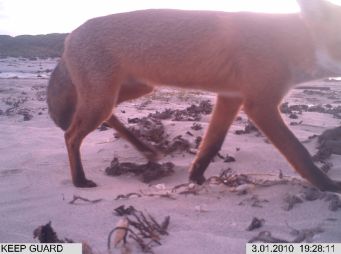
Fox visiting nest, with an egg in the nest beside the left front leg of the fox. Image taken with Keep Guard remote camera, setup and monitored by Birdlife Australia.
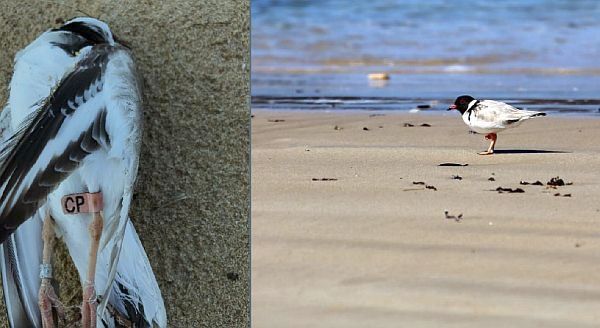
Entangled Hooded Plover at Bancoora Beach (left) Photos: Robin Spry; found dead on 6th July 2020, David Turner; CP at Bancoora Beach on 14th March 2019 (right). Source: Word about the hood Edition 24, 2020.
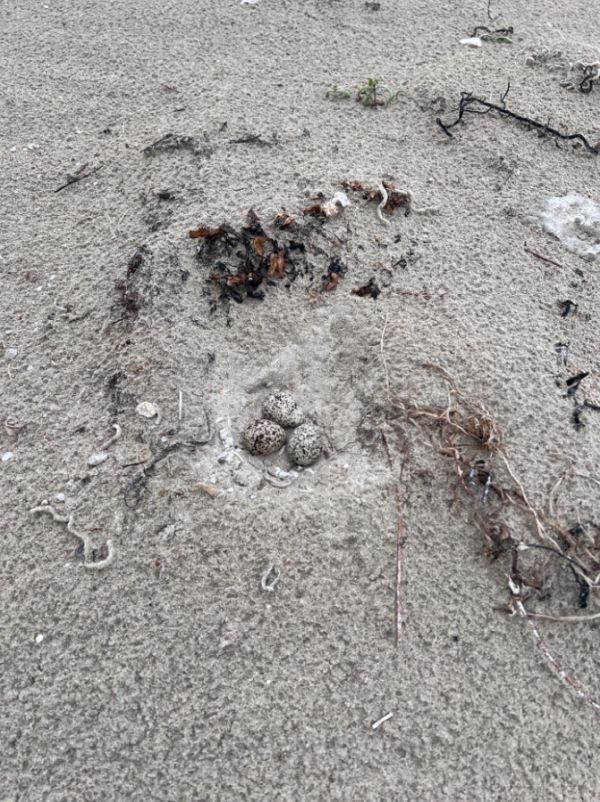
Hooded Plover nests can be located on open beach areas and sometimes difficult to see. The above image shows a nest with 2 eggs which can easily be disturbed by humans, please stay clear and help their chances of survival. Image: Courtesy of Finn Saurine, Birdlife Australia, image taken as part of official monitoring program.
Conservation & Management
A key measure is to ensure the Hooded Plover's feeding and nesting areas are retained in natural conditions with minimal disturbance from predators and human activities.
Management reports
Two important reports have been produced in recent years:
- In 2003, Parks Victoria commissioned a report; - Risks to Hooded Plovers on Parks Victoria managed land (Weston 2003)
- In 2014, Birdlife Australia completed a report - Managing the Hooded Plover in Victoria: A site by site assessment of threats and prioritisation of management investment on Parks Victoria managed land.
Both reports provide more detailed analysis of risks and threats and management options relating to Victoria.
A report released in 2018 looks at 10 years of Hooded Plover recovery on the Bellarine Peninsula and Surf Coast – an overview and future recommendations. View report pdf
Volunteer to helping beach-nesting birds
Birdlife Australia has launched the 'beach-nesting birds hub', a one-stop shop for volunteers and land managers which houses all Beach Nesting Birds resources as well as facilitating registration and training for the program: https://beachvol.birdlife.org.au/login/index.php
Monitoring counts
Every second year counts are conducted along Victoria's ocean beaches by walking along pre-selected ocean beaches, the next count is scheduled for 2012. Additional counts for odd years is proposed, these would take place in Autumn rather than Summer. Counts are co-ordinated through Birdlife Australia.
A five year overview of breeding success from 2008-2012 found that across 90-100 breeding sites in Victoria, the number of fledglings for each season ranged between 30 – 40, except for the 2009/10 season when there were 70 fledglings (Birdlife Australia 2012). .
Selected count information for Victoria
2010/11
- 213 Hooded Plover adults and 9 juveniles between Queenscliff and the South Australian border which is similar to previous counts.
2011 / 2012
- 37 nests, 31 failed, 85 eggs, 25 chicks, 12 fledged.
2013/14
Summary adapted from Beach Nesting Birds - Word about the Hoodi (Birdlife 2014)
- The overall breeding success in Victoria was similar to other seasons although some traditional areas were down whilst some old non productive sites were successful.
- Warrnambool and Yambuk coast - high chick survival.
- Bellarine Coast, Point Lonsdale and Ocean Grove, four chicks fledged due to an incredible volunteer effort
- Point Roadknight & Moggs Creek - 3 fledglings.
- Mornington Peninsula had the worst season experienced to date, one chick successfully fledged this season, Friends of the Hooded Plover Mornington Peninsula Inc. over 35 Hooded Plover pairs monitored over the Peninsula, 139 eggs found and 34 chicks observed.
- Philip Island 21 nests with 50 eggs of which 22 hatched Eight chicks fledged on Phillip Island for the 2013-14.
- Bass Coast - 7 Fledglings from 29 breeding pairs with a 6.4% success rate for eggs to fledgling.
- South Gippsland - Waratah Bay six fledglings.
- Eastern Victoria struggled to produce chicks this season.
2015/16
- 585 Hooded Plovers (569 adults and 16 juveniles) counted; The highest densities were;
- Warrnambool to Yambuk (2.44 birds/km).
- Between Princetown and Warrnambool (1.14 birds/km),
- Mornington Peninsula (2.15 birds/km).
- Phillip Island (1.19 birds/km).
- Bass Coast, between San Remo and Inverloch (1.63 birds/km).
- Venus Bay (1.04 birds/km).
2016/17
Phillip Island Nature Parks environment rangers and dedicated volunteers have managed and monitored the Hooded Plovers at Philip Island. The 2015/16 season was a record year, with a total of 17 chicks fledging this season, from both the North and South coasts of the island.
The bi-annual count at Phillip Island in November 2016 had a total of 47 Hooded Plovers which was the highest number recorded in 16 years of monitoring.
2017/18
Mornington Peninsula - 17 nests. and a record number of 13 chicks fledged this season. The last 2 chicks fledged on 1 May 2017
Bellarine Peninsula - 19 breeding pairs between Point Lonsdale and Lorne only a single Torquay chick survived to fledgling stage. Five pairs made 22 nests on the surf beach between Point Lonsdale and Collendina. Two nests were successfully incubated but those five chicks all died within several days of hatching. All other nests failed at the egg stage – to fox, unleashed dog or swamped.
Bass Coast - 32 pairings were monitored, 101 nests, 226 eggs recorded over the season but only 10 chicks made it to fledgling stage. Most nest sites were within enclosures but Fox and Raven predation along with tidal inundation to a lesser extent were the main impacting threats.
Surf Coast - Only 1 chick made it to fledgling stage in the Pt Impossible area near Torquay. A new pair was recorded between Hutt Gully and Urquharts Bluff but failed to produce any offspring. A known pair at Pt Roadknight were also unsuccessful in producing offspring.
Phillip Island - 33 nests found; 13 hatched (39.4%) 32 chicks produced; 13 fledged (40.6%) This is the second highest number of chicks fledged on Phillip Island on record.
Western Port Bay - At Pt Leo there were 22 nests, 40 eggs and 10 chicks but only 3 chicks made it fledgling stage. At Balnarring 10 nests were recorded, with 19 eggs, 8 chicks and 2 fledglings. A total of 421 surveys were completed. There was an average of one dog per survey with dogs twice as likely to be off lead as on.
2018/19
A phenomenal effort was undertaken by volunteers across Victoria to monitor the Hooded Plover breeding season. The Birdlife Australia Beach Nesting Birds Team received 6,673 data entries across Victoria to the My Beach Bird portal, representing as many visits to breeding pairs.
4,422 threat assessments were carried out (people, dogs, horses, vehicles, predators) and 3,783 of these also included an assessment of prints present in the sand around the breeding zone (which better records some threats that are harder to detect, e.g. foxes).
At least 205 nests at individual sites were protected through signage and fencing (not including those where only temporary access point signage was erected). A total of 82 fledglings were produced from 222 pairs monitored (38 from 98 pairs in Victoria and 44 from 124 pairs in South Australia). This information is obtained where the Birdlife team had enough data to follow nesting progress through. Some regions met the target, a few exceeded it but a few others had lower than expected success.
Several regions in Victoria did better than others, with the worst results occurring in far west Victoria (which is unsurprising given the escalating threats), and South Gippsland having too limited monitoring to assess success.
Preliminary results across Victoria.
- Far West Vic, 17 fledglings, 13 of 56 pairs
- Bellarine 6 fledglings, 5 of 16 pairs
- Surf Coast 4 fledglings, 2 of 9 pairs
- Mornington Peninsula, 12 fledglings, 9 of 29 pairs
- Phillip Island, 9 fledglings, 20 pairs (45 nests, 111 eggs of which 38 hatched and 9 fledged - 29 chicks died).
- Bass Coast 22 fledglings, 11 of 37 pairs
- South Gippsland, 1 fledgling, 4 pairs
Corner Inlet – the Beach Nesting Birds team intensively surveyed the Corner Inlet islands The total number of Hooded Plovers (average 65 adults. There appears to be 9 Hooded Plover territories on Snake Island, 6 on Clonmel, 4 on Boxbank Island and 4 on Dream Island.
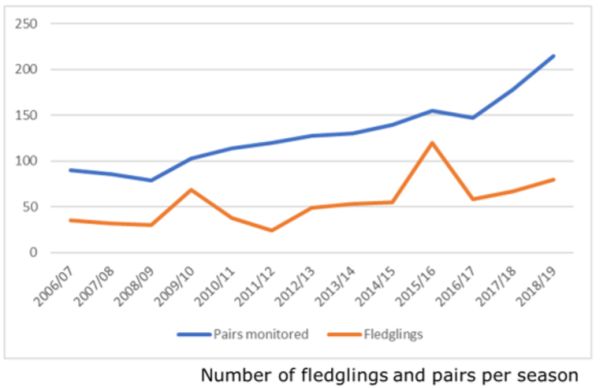
Long-term analyses of Hooded Plover monitoring data for all areas. The number of fledglings and nesting pairs has increased over time. Monitoring of nests found that signage and fencing of nests produces a significant improvement in hatching and fledging compared to pairs that are offered no protection. Source: 7th National Beach-nesting Birds Conference, May 2019, Inverloch, Victoria.
2019/20
In Victoria, the 2019/20 nesting season had a higher than normal failure rate at the nest stage across many locations. The nest failure is attributed mainly to natural climatic conditions such as storm events, tidal surges and erratic weather. Predation of chicks by foxes, ravens, magpies and silver gulls was observed at many nests. In addition, volunteers had a massive task in ensuring people and pets were kept away from the nesting areas.
Preliminary results across Victoria
- Far West Victoria (Port Fairy to Yambuk) - 18 pairs identified; 4 fledglings. (Belfast Coastal Reserve, between Warrnambool and Port Fairy) - 7 fledglings. (Logan’s Beach, east of Warrnambool) - 1 fledgling
- Surf Coast (Bancoora/Black Rock) – 3 nests, 4 eggs, 2 chicks, 1 chick fledged at Bancoora. Torquay - 1 fledgling at Nude Beach. Aireys Inlet to Fairhaven - 2 fledglings
- Bellarine (Point Lonsdale area) - 2 fledglings
- Mornington Peninsula (Montforts Beach) - 3 fledglings
- Phillip Island - 19 breeding pairs had 41 nests with 90 eggs. 24 chicks hatched from 11 nests and 9 survived to fledge successfully from 6 nests.
- Corner Inlet - 42 Hooded Plover nests recorded from monitoring on three of the barrier islands over 8 consecutive trips but no record of any successful chicks reaching fledgling stage.
- Mallacoota - 2 chicks reached fledgling stage
2020/21
- Far West Coast - 56 breeding sites monitored which produced 16 fledglings
- Shipwreck Coast – 9 known breeding pairs, 4 chicks which made it to fledgling
- Surf Coast - 9 breeding pairs, 17 nests, 5 chicks and 1 fledgling
- Bellarine Peninsula - 10 Breeding Pairs, 34 Nests, 88 Eggs, 18 Chicks, 6 Fledglings
- Mornington Peninsula - 30 active breeding pairs which achieved 21 fledglings
- Phillip Island - 18 pairs had 46 nests, 101 eggs from which 28 hatched and 11 made it to fledgling stage from 7 nests
- Bass Coast – 5 fledglings (a highly concentrated human presence on beaches was noted throughout the summer period after Covid lockdown restrictions were eased in November 2020).
- South Gippsland – 4 pairs monitored of which 2 pairs produced 3 three chicks which made it to fledgling stage
- East Gippsland - 34 Hooded Plovers observed but limited breeding success
- Mallacoota and the Croajingolong Coast - 13 fledglings
2021/22
Overall results indicate the Victorian population of Hooded Plovers did not reach the same level of breeding success as in South Australia. In Victoria, there were 52 fledglings from 142 pairs compared with 95 fledglings from 104 pairs in South Australia.
- Far West Coast - 29 chicks, 10 reached fledgling stage
- Shipwreck Coast – 10 nesting attempts, 26 eggs, 8 chicks hatched, 5 reached fledgling stage
- Surf Coast - 8 breeding pairs with 20 nests but only 3 fledglings
- Bellarine Peninsula - data to be provided
- Mornington Peninsula - 32 active breeding pairs, 92 nests, 214 eggs, 52 chicks of which 5 fledged
- Phillip Island - 19 breeding pairs, 29 nests, 70 eggs and 25 chicks, of which 14 chicks survived to fledge from 12 nests
- Bass Coast – 11 fledglings mainly from the western end of Bass Coast. In the Inverloch, Bunurong Coast and Cape Paterson areas -7 breeding pairs, 46 eggs but no fledglings
- South Gippsland – 11 pairs, 13 nests, 33+ eggs, 3 reached fledgling
- East Gippsland - Several nests produced 6 fledglings
- Mallacoota and the Croajingolong Coast - 1 pair 2 nests, 4 fledglings
2022/2023
Generally poor results compared to recent seasons with impacts being attributed to a combination of factors including a very busy holiday season with high human presence. On the Shipwreck Coast there were reports of many more dogs on the beaches. On the Surf Coast there were reports of high numbers of ravens and magpies impacting on nests combined with a high presence of foxes.
At several locations reduced nesting site availability was noted due to high water levels and swells washing away nests.
- Shipwreck Coast – Shipwreck Coast – 11 nesting attempts, 29 eggs, 5 chicks, none survived.
- Surf Coast (Moggs Creek, Urquharts Bluff, Aireys Inlet, Pt Roadknight, Pt Impossible, Point Addis – at least 13 nests, 4 fledglings.
- Bellarine Peninsula - data to be provided
- Mornington Peninsula - large number of nesting attempts failed, 4 fledglings.
- Phillip Island - 6 fledglings.
- Bass Coast – 14 sites with chicks, 1 confirmed fledgling.
- Cape Paterson - 4 nests 6 chicks 4 fledgling.
- South Gippsland (Sandy Point) – 2 chicks, no fledglings.
- East Gippsland (Cape Conron) – 5 pairs nesting, no results on fledglings.
- Mallacoota and the Croajingolong Coast - 1 fledgling.
Results from the 2022 Biennial Hooded Plover Population Count
Surveys were conducted across the known range of Hooded Plovers in South Australia, Victoria, New South Wales and Tasmania from mid to late November 2022. The surveys comprised 430 participants who undertook 642 surveys.
- Victoria (86% of habitat surveyed): 761 Hooded Plovers (756 adults and 5 juveniles)
- South Australia (98% of habitat surveyed): 838 Hooded Plovers (803 adults and 35 juveniles)
- New South Wales (98% of habitat surveyed): 65 Hooded Plovers (63 adults and 2 juveniles)
- Tasmania: 420 Hooded Plovers (411 adults and 9 juveniles)
The Warrnambool to Yambuk coastline had the highest density of Hooded Plovers across the survey area.
2022 Biennial Hooded Plover Population Count – Victoria
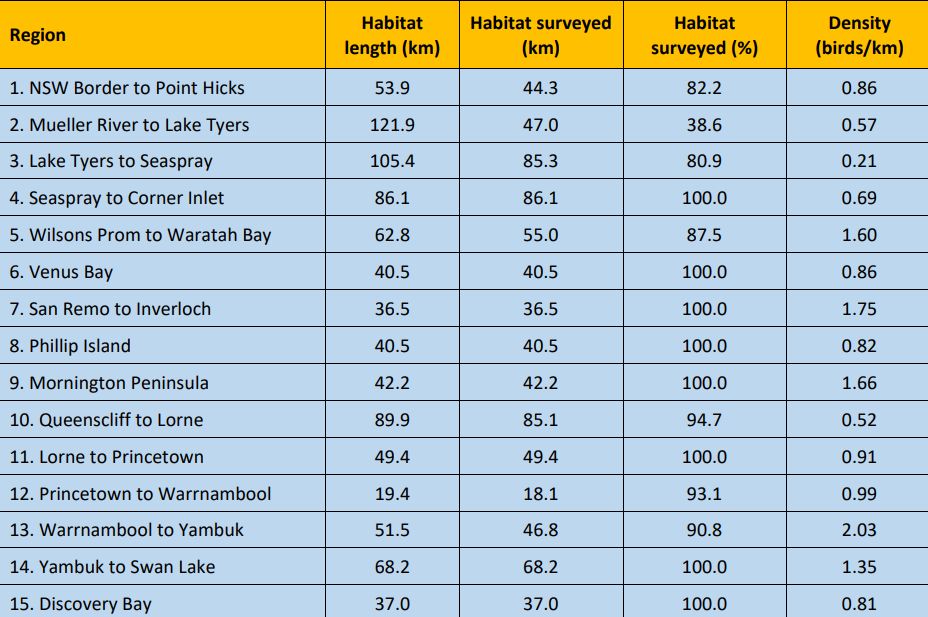
Density of Hooded Plovers. Adapted from Report on the 2022 Biennial Hooded Plover Population Count (birdlife.org.au)
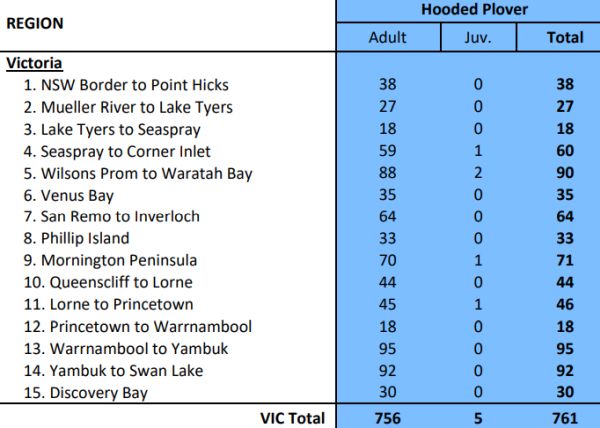
2024/2025
Summary of Hooded Plover breeding in Victoria (Additional data to be added).
- Far South West – South Beach Port Fairy 2 nests 2 fledglings (1 pair 5 nesting attempts – 1 fledgling); Cape Bridgewater 3 nests, 9 eggs 1 fledgling
- Surf Coast - (Lorne, Pt Roadknight, Pt Impossible) 5 fledglings
- Bellarine Peninsula – Barwon Heads, no chicks survived; Breamlea 1 fledgling; Point Lonsdale 2 chicks didn’t survive
- Mornington Peninsula - (further details required)
- Phillip Island - 13 fledglings from 17 pairs
- Bass Coast - (Kilcunda to Cutlers Beach at least 11 fledglings), Cape Paterson 1 fledgling, (Harmers Haven to Waterfall Ck. 2 fledglings)
- South Gippsland - Sandy Point – 9 breeding pairs, Dream Island - 3 breeding pairs, Cotters Beach - 16 recognised breeding territories
- East Gippsland - Cape Conron (further details required)
- Mallacoota and the Croajingolong Coast – 2 sites 6 fledgling, flock of 10 adults
Results from the 2024 Biennial Hooded Plover Population Count for Victoria, New South Wales and South Australia
The following summary information is adapted from; Report on the 2024 Biennial Hooded Plover Population Count – Birdlife Australia
Surveys were conducted across the known range of Hooded Plovers in South Australia, Victoria, New South Wales and Tasmania from mid to late November 2024, focused on the 16-17 November. The surveys comprised 372 participants who undertook 624 surveys. The total count for South-east Australia was 1642 Hooded Plovers (approx. 91% of the estimated number of birds in the mainland population and 55% of the world population (eastern subspecies).
- Victoria (85% of habitat surveyed): 682 Hooded Plovers (679 adults and 3 juveniles)
- South Australia (89% of habitat surveyed): 892 Hooded Plovers (860 adults and 32 juveniles)
- New South Wales (99% of habitat surveyed): 68 Hooded Plovers (68 adults and 0 juveniles)
- Far west Victoria - Warrnambool to Yambuk (2.07 birds/km)
- Bass Coast - San Remo to Inverloch (2.02 birds/km)
- Mornington Peninsula (1.72 birds/km)
- South Gippsland - Wilsons Promontory to Waratah Bay (1.65 birds/km)
- Yambuk to Swan Lake region 27% reduction in Hooded Plover numbers.
- Lake Tyers to Seaspray region, a 50% decline
- Mueller River to Lake Tyers and Princetown to Warrnambool.
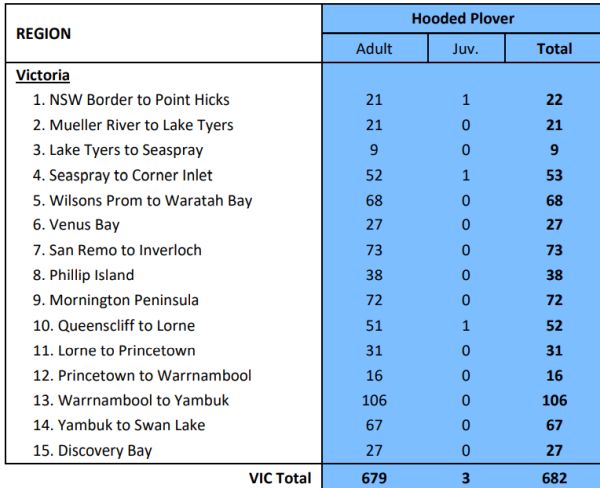
2025/2026
The first recorded successful fledglings occurred on 8th & 9th November 2025 at Dutton Way, Portland with 2 fledglings and Bridgewater Bay Kiosk, 1 fledgling.
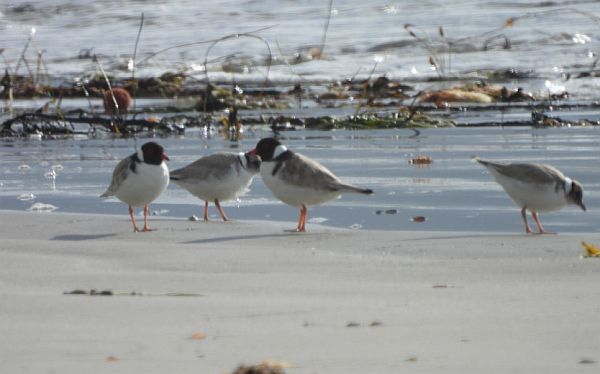
Data souce: Biannual newsletter of BirdLife Australia’s Beach-nesting Birds Program
- Word about the Hood Edition 25 Winter 2021 pdf
- Word about the Hood Edition 26 Spring 2021 pdf
- Word about the Hood Edition 27 Winter 2022 pdf
- Word about the Hood Edition 28 Summer 2023 pdf
- Word about the Hood Edition 29 Spring 2023 pdf
- Word about the Hood Edition 30 Autumn 2024 pdf
- Word about the Hood Edition 31 Summer 2024/25 pdf
- Word about the Hood Edition 32 Autumn 2025 pdf
- Word about the Hood Edition 33 Summer 2025 pdf
Coastal management
Parks Victoria is responsible for managing 76.1% of the statewide Hooded Plover population. A report by (Birdlife Australia 2014) found that in three of the five consecutive breeding seasons over which monitoring occurred (2006/07-2010/11), breeding success (standardised as the number of fledglings per pair) was lower on Parks Victoria managed coastline than for pairs on non-Parks Victoria managed coastline.
Areas where there is active management and high volunteer support tend to be more successful e.g. increases in successful fledging occurred within the Bellarine Peninsula and Surf Coast on land managed by Committees of Management and local councils supported by active conservation group involvement .
Monitoring breeding success
Scout guard (remote) cameras are being used to monitor selected nests to detect their fates and to better document hatching success rates, especially to understand whether there are different suites of predators for dune versus beach nests (often nests fail on the day they were due to hatch, so to know whether they have definitely hatched is very important information).
A new colour marking system was introduced in 2010 which has engraved (with two letters) orange flags on the upper leg as opposed to the other systems of 3 colour bands method of identification. The aim is to determine the survival rate of fledglings as there is a big gap in knowledge of what happens to fledglings. By late December 2010, 17 Hooded Plovers on the Bellarine Peninsula and Bass Coast had been flagged. Numerous reports were received which has enabled the tracking movements from Barwon Heads to Torquay for example.
Commencing in 2016, a Deakin University honours student will study the movements and fate of Hooded Plover chicks to gain a greater understanding of chick movement, the threats they face and identify the main causes of mortality. The study covers three regions: the Mornington Peninsula, Bass Coast, and Bellarine/Surf Coast.
Research
2019/20
The effects of horses on sandy shore infauna, Madison Evans-Clay - Deakin University
The influence of human disturbance on parental care in Hooded Plovers, Lucy Doran, Honours student co-supervised by Mike Weston and Grainne Maguire, Deakin University Burwood
Non-breeding habitat of Hooded Plovers – Filling critical information gaps to aid species recovery, Madeline Barker, Honours Student, Deakin University Burwood
2020/21
During 2021 research is being conducted to reduce the predation of Hooded Plover eggs from ravens by taste aversion experiments which involves the use of quail eggs treated with an unpleasant taste to Ravens. The research is hoping to determine if ravens can be discouraged from eating plover eggs through learning the eggs will have a bad taste. Contact: Kasun Ekanayake, Beach-nesting Birds Program Coordinator, BirdLife Australia.
2022/23
Use of the 'Felixer' feral cat control trap has been the subject of research in the control of feral cats at a number of sites around Australia.
A research program using the Felixer feral cat control trap for the control of foxes impacting on the Hooded Plover population at is being carried out at Three Hummock Island , Tasmania.
Research paper - Effectiveness of the Felixer grooming trap for the control of feral cats: a field trial in arid South Australia. More about Felixer
Research Papaer - Bad dog? The environmental effects of owned dogs, P. Batman & L. Gilson, Pacific Conservation Biology 31, PC24071 https://doi.org/10.1071/PC24071 CSIRO Publishing 10 April 2025.
Specific management actions
Of the 74 sites monitored by Birdlife Australia, 82.4% require nest site protection, 54% require dog management, 30% require horse management and 45%require vehicle management (Birdlife Australia 2014).
- Ensure that conservation of the Hooded Plover is considered in all feral Cat and Red Fox control programs in coastal areas particularly those managed by Parks Victoria and Coastal Committees of Management.
- Encourage local bird observers and field naturalist clubs, friends groups and other interested bodies to begin or continue to monitor local populations, and especially nest sites.
- Encourage local bird observers and field naturalist clubs, friends groups and other interested bodies to begin or continue to monitor local populations, and especially nest sites.
- Use signs and information shelters in areas of high visitor use to promote public awareness of Hooded Plover habitat and survival requirements.
- Control illegal vehicle use of beaches, horses ridden above the high-tide mark and dogs off leashes.
More detailed management actions are contained in the FFG Action Statement and Birdlife Australia report 2014.
Recent management initiatives
- Dog ban on Mornigton Peninsula
As of 1 November 2016 dogs are no longer permitted in the Mornington Peninsula National Park. This will be of great assistance in protecting Hooded Plovers.
- Bass Coast Shire Council Hooded Plover Strategy>
The 2016 Bass Coast and Phillip Island Hooded Plover Strategy pdf
Feral cats declared a pest animal on public land
On 26 July 2018, feral or wild populations of the cat (Felis catus) were declared an established pest animal on public land to help protect Victoria’s at-risk biodiversity and give threatened species the best chance of survival. This legislation was made under the Catchment and Land Protection Act 1994 (CaLP Act 1994). Further details: Information sheet by DELWP
New protection for 25 salt-wedge estuaries in western and central Victoria
On 22 October 2018, ’Assemblages of species associated with open-coast salt-wedge estuaries of western and central Victoria’ were declared endangered under the Environment Protection and Biodiversity Conservation Act 1999. This means 25 open-coast salt-wedge estuaries of western and central Victoria and the ecological communities they support will be better protected. Ecological communities consist of assemblages of native plants, animals and micro-organisms including species that are listed as threatened at a national or state level e.g. Hooded Plover. Further details - Australian Government legislation.
Phillip Island cat control
During 2017-18 financial year, 154 feral cats were removed from the island. Over the past 20 years more than 2,300 feral cats have been removed from Phillip Island in control programs.
The on-going removal of feral cats combined with other management and monitoring efforts by volunteers, Birdlife Beach Nesting Birds project and Philip Island Nature Parks has resulted in a steady increase in the population of Hooded Plovers at Phillip Island.
Projects & Partnerships
“Case studies of motion-sensing cameras to study clutch survival and fate of real and artificial ground-nests in Australia”. Published in the international journal, Bird Study (Weston, M.A., Ekanayake, K.B., Lomas, S., Glover, H.K., Mead, R.E., Cribbin, A., Tan, L.X., Whisson, D.A., Maguire, G.S. and Cardilini, A.P., 2017. Bird Study, pp.1-16.). Abstract.
This research was conducted to investigate the effect of urbanisation on clutch success, to the usefulness of nest protection cages, identifying key threats, and even assessing whether artificial nests reflect real nests accurately. It provides a comprehensive account to date of the fate and survival of clutches of ground-nesting birds in Australia. Cameras enabled the survival and fate of most nests to be determined.
Partnerships
- Birdlife Australia
- Bass Coast Shire
- DELWP
- Parks Victoria
- Phillip Island Nature Park.
- Selected Coastal Committees of Management
- Friends of Hooded Plover Groups
- Selected Field Naturalists Clubs
- Selected Landcare Groups
- ANGAIR
- Individual volunteers
Beach Nesting Birds Hub
This hub has been designed for people with a general interest or who want to participate in Beach-nesting Bird conservation. Here you can access all the information you will need to become involved in helping beach-nesting birds.
%20Crumpet%20Beach%20600.jpg)
References & Links
- Birds Australia (2008) The ‘promoting coexistence between recreationalists and beach nesting birds’ project 2007-2008 breeding season report.
- Birdlife Australia (2012) Eastern Mainland Australia Hooded Plover Recovery Workshop 2012, (pdf) Report by Tanya Pyk and Grainne Maguire BirdLife Australia June 2012.
- Birdlife Australia (2014) Managing the Hooded Plover in Victoria: A site by site assessment of threats and prioritisation of management investment on Parks Victoria managed land. Report by (Maguire, Cullen & Mead 2014).
- Birdlife Australia (2024) Report on the 2024 Biennial Hooded Plover Population Count – Birdlife Australia
- Birdlife Australia (2023) Report on the 2022 Biennial Hooded Plover Population Count (birdlife.org.au)
- Birdlife Australia (2014) Report on the 2014 Biennial Hooded Plover Count (pdf), Joris Driessen and Grainne Maguire, Birdlife Australia.
- Department of the Environment & Energy, Australia - Hooded Plover, Species profile & threats database
- EA (2000) Dept.of Environment & Heritage, The Action Plan for Australian Birds 2000, Hooded Plover recovery outline -(pdf) Stephen T. Garnett - Queensland Parks and Wildlife Service, and Gabriel M. Crowley - Birds Australia, Environment Australia, 2000.
- FFG Threatened List 2025, Department of Energy,Environment and Climate Change (DEECA), March 2025.
- Flora & Fauna Guarantee Action Statement No. 9, Hooded Plover, Dept. Sustainability & Environment, Victoria (now Department of Environment, Land, Water & Planning).
- Lane, Brett, A. (1987) Shore Birds in Australia, Royal Australasian Ornithologists Union, Nelson Publishers, 1987.
Maguire, G., Ekanayake, K., Cullen, M., Mead, R. and Rhodes, L. (2018). Ten years of Hooded Plover recovery on the Bellarine Peninsula and Surf Coast – an overview and future recommendations. BirdLife Australia report, Carlton, Victoria. http://www.birdlife.org.au/documents/bnb_Bellarine_Surf_Coast_final_MS_PDF_opt.pdf
TSP Act (1995) Threatened Species Protection Act 1995. Tasmanian Government. Tasmanian Legislation on-line.
- VBA (2019) Victorian Biodiversity Atlas, Department of Environment, Land, Water & Planning, Victoria. Accessed 15 January 2019.
- Weston, Michael, A., (2003) The Hooded Plover in Victoria: a review of existing information, Parks Victoria Technical Series, No.4. pdf
%20Crumpet%20Beach%20600.jpg)
See also:
- Beach nesting birds hub
- My hoodie - A guide to the amazing breeding lives of Hooded Plovers
- Birdlife Australia - Beach-nesting Birds
Hooded Plover: the life and challenges of our hoodies. Source: Birdlife Australia.
Please contribute information regarding Hooded Plover in Victoria - observations, images or projects. Contact SWIFFT

